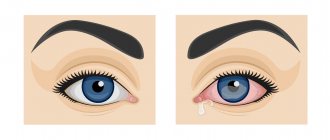Color blindness (color blindness)
- a congenital or acquired visual impairment, which manifests itself in the inability of the eye to distinguish one or more primary colors.
The disease was first described in 1794 by the English scientist John Dalton, who observed this disease in himself and several members of his family. Scientific work was recognized as innovative, as it influenced the development of medicine.
Features of the disease
The center of the retina contains photoreceptors, whose main role is to perceive colors and their shades. These cells are called cones and contain red, yellow or blue pigment.
In this article
- Features of the disease
- How is color vision defect transmitted?
- How color blindness is inherited
- Types of color blindness
- Signs of color blindness
- Tests to detect color blindness in humans
- Features of children's color blindness
- How can you independently determine that a child is colorblind?
- Is it possible to cure hereditary color blindness?
The rest of the color spectrum appears when the base colors are superimposed.
Impaired color perception is caused by the absence or deficiency of a certain pigment. Most often, the defect is associated with red-green vision: this problem occurs in 8% of affected men and 0.5% of women. In this case, the pigment is usually present in the cell, its activity is simply somewhat reduced. When there is a deficiency of red color, dark green and dark brown colors are mixed. Determining the presence of color blindness in people is not easy, because there are no external signs of this disease. If there are already colorblind people in the family, then the risk that the child will inherit colorblindness increases. In this case, you need to see a doctor to check your baby’s color vision when he reaches 3 years of age.
In cases of hereditary color blindness, people do not distinguish a certain color, but their eyes are more receptive to other shades. Due to this, the color spectrum of people with the disease can be much wider than that of healthy people.
Why do some people see colors and others cannot?
It is still not possible to answer this question completely. It is known that the cells located in the retina of the human eye, similar in shape to a chemical flask (they, by the way, are called cones), are divided into three types.
Each type of cell is excited by one of three colors: red, green or blue. True, they all react to other colors. The cells contain special colored substances - pigments that transmit light waves only of a certain length.
Excitation of one “type” of cells gives a feeling of the corresponding color, except for white, which is obtained when all cones are “turned on.” All other colors and shades are complex variations of intermediate states.
If one of the pigments is missing in the cones, then a person cannot see the corresponding color. In addition, due to this loss, the perception of some shades is also distorted. This theory, however, does not explain all congenital color perception disorders.
Therefore, scientists have recently suggested that colorblind people have a slightly different pigment that does not perform its duties well. The following situation is also possible: the pigments are normal, but they end up in “not their own” cells - for example, a “green” pigment ends up in “red” cones.
This confusion also makes it difficult to transmit other normal signals to the brain. But explaining does not mean curing. Unfortunately, there are no methods for treating congenital color blindness yet (although contact lenses have appeared in the West, with the help of which colorblind people can see the world in its pristine beauty).
And now about why such a scourge falls mainly on men. Genetics were able to answer this question. It turned out that the “responsibility” for the occurrence of color blindness in men lies with women.
They are the hidden carriers of a defective gene that causes color vision impairment. Why does this gene manifest itself in a male body, but not in a female body? The fact is that the pair of chromosomes responsible for a person’s gender exists in two versions.
In women its components are identical, but in men they are not. Female sex chromosomes are usually designated by the Latin letter “X”. Women have two X chromosomes (XX), and men, in addition to the X chromosome, also have a small chromosome, which is designated by the Latin letter “Y”.
That is, the “gentleman’s” set is XY. The gene for color blindness lies on the X chromosome, and its “strength” is low. If a person has a normal, unmodified gene, then it cannot express itself.
It is clear that in women with two X chromosomes, the appearance of congenital color blindness is possible only if there are defective genes on both chromosomes. This situation is extremely rare.
But there is no gene on the Y chromosome that can “silence” its unsuccessful partner, so the color blindness gene manifests itself quite often in men. Surprisingly, many people with impaired color perception learn about this feature of theirs by accident.
It turns out that they gradually “learn” to distinguish colors according to their degree of brightness, which partly compensates for their deficiency. Moreover, they do this so successfully that only a specialist can “expose” this roundabout way of perception.
How is color vision defect transmitted?
Now that the features of the disease have been described, it is worth understanding how color blindness is inherited.
Color blindness is not an independent disease; it is associated with genetics. But this does not mean that color blindness is always inherited. It also happens that color blindness occurs as a symptom of a disease, the result of age-related changes or eye injury. How color blindness is inherited depends on the expected sex of the child and which parent has the “wrong” gene. In the vast majority of cases, the disease is found in men.
The inheritance of color blindness is directly related to the sex X chromosome - this is where the defective gene is located. At the same time, it is recessive and does not manifest itself in any way if there is a dominant one.
This explains that the mother can be a carrier of this recessive gene, but since she has two XX chromosomes, the second, healthy one, blocks the defective one and, accordingly, the woman will not get sick. The carrier of the defective gene is the mother: she passes it on to her son and, as a rule, remains healthy herself. When this gene is passed on to a daughter, the genetically “wrong” chromosome, just like the mother’s, is replaced by a healthy one.
As for men, they have XY chromosomes, so when a defective gene is passed on to them, they often become color blind. Inheritance of color blindness by sons is possible only from the mother. Sometimes daughters get sick too, but then both parents must be colorblind.
Genetics of inherited color vision problems
Most color vision problems are associated with genes that regulate the production of pigments in the cone cells that sense color. The cone genes responsible for the perception of red and green colors are located on the X chromosomes.
Women have two X chromosomes. Males have only one X chromosome and a Y chromosome, and they inherit their X chromosomes from their mother.
- A man will have a color vision problem in the red-green range if the defective gene is on his only X chromosome. A woman may have a defective gene on one of her two X chromosomes that can cause color vision problems, and this is much less common than in men.
- A woman who is gifted with the gene for this type of color vision problem has a 50% chance of passing the gene on to her sons (because they will inherit one of the two X chromosomes). Her daughters may have this kind of problem if they inherit a defective gene on the X chromosomes from both their mother and father. This is a much less likely case.
This is why color vision problems can occur across generations in families that have a genetic predisposition to color vision problems.
The genes responsible for retinal cone pigment and responsible for seeing blue colors are not found on the X chromosomes, but are found on the non-sexual chromosome, which both males and females have.
This means that blue-related color vision problems are equally common in men and women. However, these types of color vision problems are relatively rare.
Types of Inherited Color Vision Problems
There are four main types of inherited color vision problems:
Trichromasia
The most common type of color vision problem, called anomalous trichromasia, occurs in people who have all three types of cone cells but are missing or have the wrong amount of one type of cone cell, or one type of cone cell is deficient in the pigments to perceive color.
People with these vision problems can see all three colors, such as green, red and blue - but not as well as people with normal color vision. Thus, they see different shades of colors differently than people with normal color vision.
Another type of color vision problem called dichromasia occurs when one of the three types of cone cones is missing. Thus, a person can only see two of the three colors.
- Most people with this color vision problem can tell the difference between blue and yellow colors, but have trouble telling the difference between red and green colors. (Very few people in this category can see red and green, but not blue and yellow.)
- People with this type of condition have more severe color vision problems than type 1 (abnormal trichromasy).
A third type of inherited color vision problem, called blue cone monochromasy, occurs when two of the cone cells (red and green) are missing.
- This type of inheritance affects only boys and men.
- Distance vision is often impaired, and boys with this condition may have involuntary eye movements (nystagmus)
- A boy or man with blue cone monochromasy sees only blue colors from the entire spectrum of colors.
The fourth and major type of inherited color vision problem, called achromatopsia, occurs when all three types of cone cells are absent.
- A person with this color vision problem cannot see the color spectrum, but only shades of grey, black and white.
- People who have this type of disease may also have other vision problems, such as poor distance and reading vision, sensitivity to light and illumination (photophobia).
- This type of color vision problem is the rarest and most severe.
- This condition is also called rod retinal monochromasy because a person's vision is primarily due to the rod retina.
How color blindness is inherited
As mentioned above, color blindness is inherited by all children, but not everyone has it. The likelihood of the disease depends on the combination of healthy and defective genes in the parents:
- the woman distinguishes colors, the man is colorblind: in such a couple, the daughters will accept the defective gene and become its carriers, while the sons will remain healthy;
- the woman is a carrier of color blindness, the man is healthy: in such parents, in half the cases, daughters will also become carriers of the gene, the probability of the disease in sons is 50%;
- the woman is a carrier, the man is colorblind: half of the daughters will become carriers, half will become colorblind, the probability of the disease for sons is 50%;
- the woman is sick, the man is healthy: girls will become carriers, all boys will have color vision impairment;
- both parents are colorblind: both sons and daughters will be sick.
Thus, it is clearly seen that the inheritance of color blindness is closely related to the gender of the child: the risk of the disease is much higher in boys. Girls are color blind only if both their father and mother suffer from color blindness. Color blindness is passed down within a family from generation to generation, so the risks of its occurrence in children can be calculated based on their pedigree.
Types of color blindness
There are several types of the disease, which depend on which of the three pigments is missing:
1. Achromasia is the inability to distinguish colors: in this case, only shades of gray are available to a person.
2. Monochromasia - the inability to see all the variety of colors. Only one color and the entire range of its shades are available.
3. Dichromasia - two colors available. It is divided into:
- protanopia - inability to see the color red;
- deuteranopia - problems with the perception of the color green;
- tritanopia - blue-violet colors are not perceived.
4. Trichromasia - all three primary colors are perceived well. It can be normal or abnormal. The latter is located in the gradation between normal trichromasia and dichromasia. If with normal dichromasia the differences between two colors are not noticeable, then with abnormal dichromasia the patient experiences difficulties not with the colors themselves, but with their shades. Just as in dichromasia, prot-, deuter- and tritanomaly are distinguished here, in which the perception of the red, green and blue parts of the spectrum, respectively, is weakened. Sometimes the lack of perception of some shades is balanced by increased perception of others, thus maintaining a certain balance. For example, patients who are unable to distinguish red tones from green can perfectly distinguish shades of khaki in quantities inaccessible to healthy people.
Each type of color blindness can be inherited. The exact causes of this disease are still unknown.
Symptoms
- Healthy people are tritanopes - they can distinguish the entire color spectrum. Color vision impairments due to color blindness can be different:
Protanopia – difficulty perceiving the color red;
Anomalous trichromacy - all colors are perceived, only incorrectly - in other shades;
Monochromacy - only one color is perceived, usually blue;
Dichromacy - only one color disappears from perception;
Achromatia is a complete lack of color perception; the whole world is seen in black and white.
All these deviations are congenital.
Signs of color blindness
The following symptoms indicate the presence of color blindness:
- red, blue or green pigments are difficult to see;
- difficult to focus your gaze;
- decreased clarity of vision;
- increased sensitivity to light;
- there is involuntary mobility of the pupil;
- objects are seen in gray tones.
The main symptom of color blindness is impaired color vision. It does not affect visual acuity. If a person is color blind from birth, there is uniform damage to both eyes, and the disease does not progress. It happens that the pigment is not completely absent, only its function is reduced. In such cases, the disease can go unnoticed for a long time: a person “guesses” the color of objects by their brightness and tone. In this case, color blindness may affect both two and one eye. As a rule, with a hereditary disease, color rendition is impaired in both eyes.
Tests to detect color blindness in humans
Hereditary color blindness is extremely difficult to diagnose in childhood because there are no external clinical symptoms. Many people learn about their disease already in adulthood: by accident or during specialized diagnostics. Polychromatic tables are used to diagnose color blindness. A person is shown 27 tables, which depict colored circles or dots of different brightness: they all make up a certain pattern. If a person has this disease, he will only see a field filled with dots or circles; if a person is healthy, he will see a picture on the card.
The Ishihara test is also used. During this procedure, the patient is given a letter consisting of bright spots. A healthy person can easily read it, but a person with color blindness will find it difficult to complete this task.
These tests are suitable for adults who do not have mental disorders. Children and adults with mental disorders can distort the results, so special tests have been invented for them that determine the presence of the disease based on indirect symptoms.
In the absence of the disease, patients give over 90% correct answers, patients with color blindness - no more than 25%.
Diagnostic methods
One of the most well-known methods for diagnosing color blindness remains Rabkin’s polychromatic tables, a test for color perception. The tables contain multi-colored circles of equal brightness. Various numbers and geometric shapes are made from circles of the same shade in the images. By the number and color of figures identified by a person, one can judge the degree and type of color blindness.
Rabkin table
You can also use the simpler tables of Stilling, Yustova and Ishihara. They were obtained by calculation and not by experiment. Doctors use the Holmgren method. According to it, it is necessary to sort skeins of multi-colored wool threads into three main colors.
And also about where you can cure retinal dystrophy here.
Features of children's color blindness
Congenital color blindness is caused by the transmission of pathological genes at the time of conception. It is possible to detect a violation of color perception in a child when it becomes clear that the baby does not distinguish between red and gray colors or green and gray. Color vision disorders can cause difficulties already in the early stages: for example, in kindergarten, color blindness can be mistaken for mental retardation. Parents should talk to a caregiver or teacher and ask them to help their child differentiate the colors he sees. This will help him feel more comfortable in classes when the child is offered visual materials, the colors of which are not accessible to the baby’s vision.
In addition, a child with impaired color vision should be seated at a desk that is not exposed to direct sunlight. The child himself needs to be explained as early as possible that he sees the world not exactly the way other people see it, but this does not make him worse. By working together, parents and teachers will be able to help colorblind children adapt to life.
How can you independently determine that a child is colorblind?
A child learns to truly distinguish colors by the age of 3-4 years, while they begin to tell him about the names of colors at 2 years old. Hereditary color blindness in children can remain undetected for a long time, because children remember the name of the color in relation to a specific object and, if necessary, name them correctly. How he really sees the object that is shown to him, he cannot say. In addition, children retain their perception of the brightness of different colors; they do not understand that they see the world differently than everyone else. To understand whether a child perceives colors correctly or not, you need to carefully observe him during creative activities. One of the simplest ways is to ask your child to depict the landscape outside the window, the characters of his favorite cartoon, or any other objects in which neither you nor he is guaranteed to make a mistake in determining the colors and shades. Based on the results, you can understand how he perceives colors.
The most obvious sign of color blindness is an error in distinguishing between red and green or replacing them with shades of brown. At the same time, it is worth noting that such a test is not considered reliable: you should always remember that the child could choose colors based on his ideas about what is beautiful. If it constantly changes colors, you should consult a doctor who will help diagnose color blindness in a medical office.
Diagnosis of color blindness in the Nearmedic network of clinics
Diagnosing color blindness is not particularly difficult - there are special tests for this with color images. It is much more difficult to predict this chromosomal hereditary disease. To do this, the Nearmedic network of clinics conducts a DNA test for color blindness. During this highly accurate study, specific mutations are identified in the genotype of the woman - the expectant mother. After this, a conclusion is issued about the likelihood of this pathology in the unborn child.
If one of your relatives suffers from color blindness and you want to get all the information on this matter, contact us at +7 (495) 6 171 171.
Is it possible to cure hereditary color blindness?
If color blindness is a hereditary disease, then you cannot get rid of it. It can be cured only if color blindness is not hereditary, but was acquired during life. Developments are underway in the field of genetic engineering: the missing gene is introduced into the retina of the eye using viral particles. So far, this technology has only been tested on monkeys; there have been no cases of its use in relation to humans. There are also correction methods using lenses. The products have a special coating that changes the wavelength of some colors. However, this method also does not completely eliminate color blindness.
You can correct your vision somewhat using:
- Light-blocking glasses: colors are easier to see in low light;
- glasses with multi-layer lenses: they allow you to make shades of red and green more noticeable, so they are suitable for mild color blindness.
For each type of color perception, our own models of corrective glasses have been developed. In the most general sense, the principle of their operation is as follows: lenses transmit only primary colors - red, blue and green, while simultaneously enhancing their perception. Thus, a person does not see those shades of the color spectrum that prevent him from distinguishing primary colors.
These correction methods allow the patient to more easily perceive the surrounding reality and improve the quality of life.
Is it possible to get rid of color blindness through surgery?
It is impossible to cure a pathology if it is hereditary. There are several ways to partially correct congenital color blindness with special lenses, glasses and contacts. As for the acquired form of this visual impairment, it is a symptom. Therefore, it is necessary to treat the underlying disease that caused problems with color perception. Thus, in case of retinal dystrophy and its detachment, laser coagulation is performed, during which the inner layer of the eye is laser-soldered to the vascular layer.
For cataracts, surgery is performed to remove the lens. Instead, an intraocular lens is implanted into the eyeball. Once the underlying disease is cured, the signs of color blindness will disappear.











